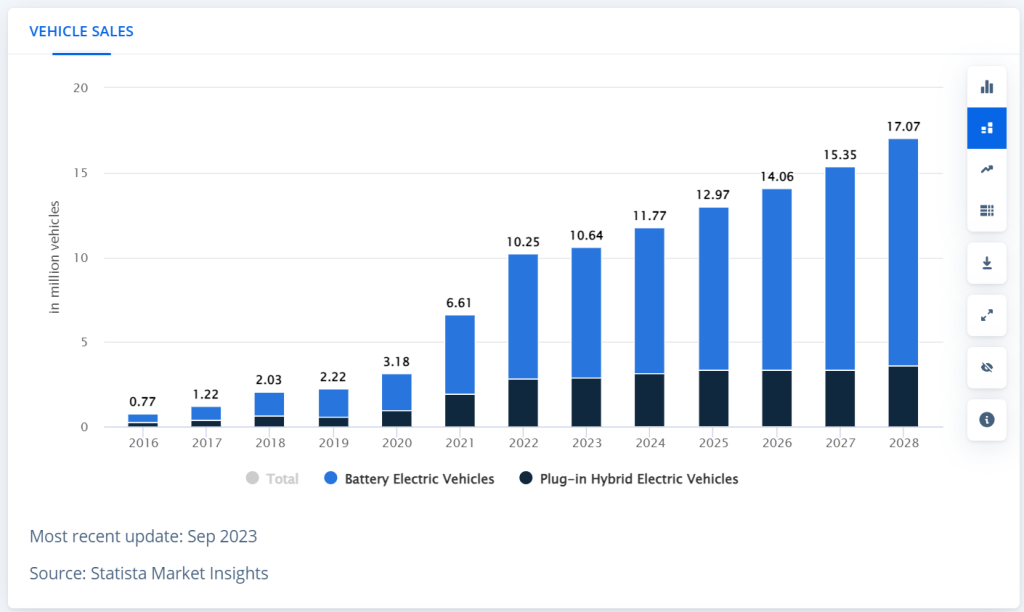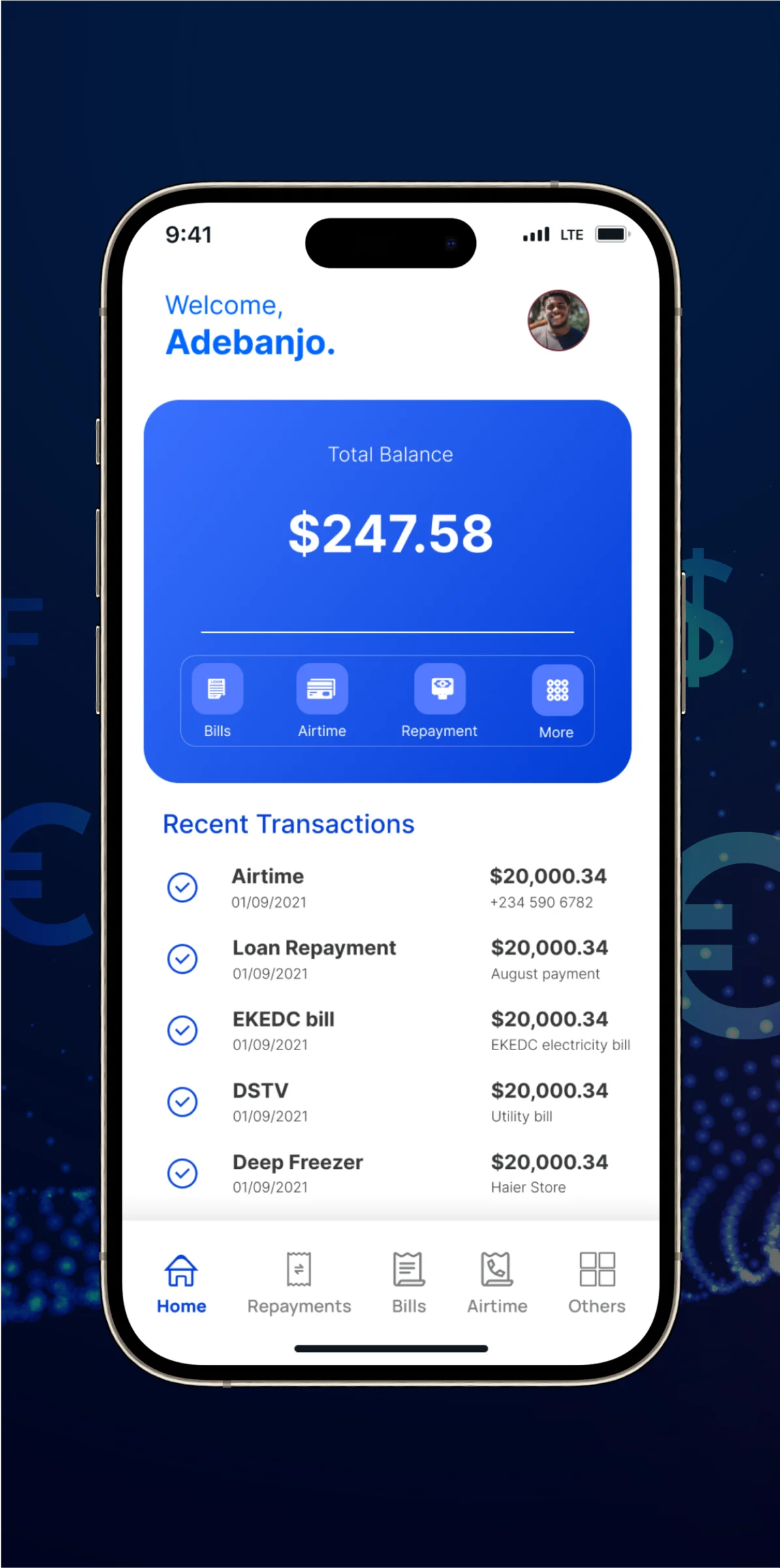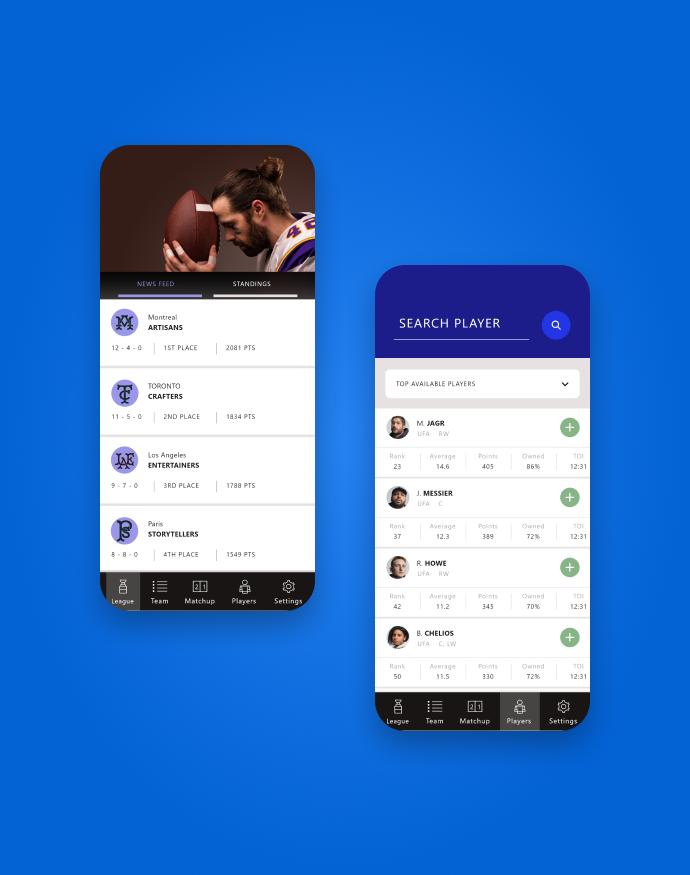- What are Electric Vehicle Apps?
- The Evolution of Electric Vehicle Apps
- Market Size and Growth Outlook
- Key Trends Driving Electric Vehicle App Development
- Electric Vehicle App Development: A Step-by-Step Guide
- Here are some of the popular EV apps in the USA as of 2024:
- Essential Tech Stack To Consider
- Cost To Build A Electric Vehicle App
- Conclusion
- How Can We Help In Electric Vehicle App Development
- FAQs

The landscape of transportation is rapidly changing in the United States, with electric vehicles (EVs) becoming increasingly popular among consumers. Alongside this surge in EV adoption, there has been a growing demand for innovative apps designed to support and enhance the EV experience. In this blog, we’ll delve into the latest trends shaping the electric vehicle app market and explore some of the most popular apps leading the way.
- What are Electric Vehicle Apps?
- The Evolution of Electric Vehicle Apps
- Market Size and Growth Outlook
- Key Trends Driving Electric Vehicle App Development
- Electric Vehicle App Development: A Step-by-Step Guide
- Here are some of the popular EV apps in the USA as of 2024:
- Essential Tech Stack To Consider
- Cost To Build A Electric Vehicle App
- Conclusion
- How Can We Help In Electric Vehicle App Development
- FAQs
What are Electric Vehicle Apps?
Electric vehicle apps are software applications designed to enhance the user experience of electric vehicle owners by providing a range of features and functionalities related to EV ownership and operation. These apps serve as a comprehensive platform for EV users, offering services such as charging station locators, battery status monitoring, remote vehicle control, trip planning, and energy consumption analysis.
The Evolution of Electric Vehicle Apps
Over the years, electric vehicle apps have evolved significantly, reflecting advancements in technology and the growing demands of EV users. Initially, these apps primarily focused on basic functionalities like locating charging stations. However, with technological innovation, modern EV apps now offer a myriad of features, leveraging connectivity, data analytics, and artificial intelligence to deliver a seamless and intuitive user experience.
Market Size and Growth Outlook

Furthermore, the rapid increase in electric vehicle adoption is evident on a global scale, with countries like Norway emerging as leaders in terms of market share. This underscores the growing awareness and acceptance of electric vehicles as a viable and environmentally friendly mode of transportation worldwide.
Key Trends Driving Electric Vehicle App Development
Here are some key trends for ev app development –
1. Charging Station Locators
One of the most significant challenges for EV owners is finding convenient and accessible charging stations. Apps like PlugShare, ChargePoint, and Electrify America have emerged as invaluable tools, allowing users to locate nearby charging stations, filter by connector type, check availability, and even view real-time wait times. These apps play a crucial role in alleviating range anxiety and encouraging more widespread EV adoption.
2. Range Anxiety Reduction
“Range anxiety” remains a prominent concern for many prospective EV buyers. To address this issue, apps such as Agero, EVgo, and Rivian offer features that provide users with estimated range calculations based on factors like battery level, driving habits, and weather conditions. By offering reassurance and practical guidance, these apps help users plan their journeys with confidence.
3. EV Trip Planning
Efficient trip planning is essential for EV owners, especially on longer journeys where access to charging stations becomes paramount. Apps like ABRP (A Better Route Planner) and TripIt for EVs offer comprehensive trip planning capabilities, taking into account factors such as charging stops, station availability, and charging times. These tools empower users to optimize their routes and minimize downtime, enhancing the overall EV driving experience.
4. Battery Health Monitoring
Maintaining battery health is crucial for maximizing the longevity and performance of an EV. Apps such as those provided by Tesla, FordPass, and MyChevrolet offer features that enable users to monitor battery health, track degradation over time, and receive tips for optimizing battery usage. By staying informed about the condition of their batteries, EV owners can take proactive steps to preserve their vehicles’ performance.
5. Peer-to-Peer Charging
Peer-to-peer charging platforms are gaining traction as a means of promoting community engagement and cost-sharing among EV owners. Apps like Neighbor and WeCharge facilitate connections between EV owners, allowing them to arrange private charging sessions and share resources. This collaborative approach not only fosters a sense of community but also helps address challenges related to charging infrastructure accessibility.
6. EV Marketplaces
The burgeoning market for electric vehicles has given rise to platforms dedicated to buying, selling, and trading EVs, as well as associated accessories and charging equipment. Apps like HeyCar and EVList serve as virtual marketplaces, connecting buyers and sellers and facilitating transactions within the EV ecosystem. These platforms offer convenience and choice to consumers, further driving the adoption of electric vehicles.
7. Gamification
Gamification has emerged as a powerful tool for encouraging eco-friendly driving and charging behaviors among EV owners. Apps such as Kilowatts and WattCat leverage gamified features such as points, badges, and rewards to incentivize sustainable practices. By turning driving and charging into a game, these apps make the EV experience more engaging and rewarding for users.
8. Subscription-Based Services
In addition to offering free features, many EV apps now provide subscription-based services that grant users access to exclusive features, charging discounts, or roadside assistance. Examples include Tesla Premium Connectivity and Electrify America Electrify+, which offer premium tiers with added benefits. These subscription models provide a recurring revenue stream for app developers while offering enhanced value to users.
Electric Vehicle App Development: A Step-by-Step Guide
From charging station locators to vehicle performance trackers, the possibilities are endless. In this comprehensive guide, we’ll take you through the step-by-step process of developing an electric vehicle app that’s sure to make waves in the market.
Understanding the Market
Before diving into the development process, it’s essential to conduct thorough market research. Get to know your target audience and their specific needs and preferences. Analyze existing EV apps to identify gaps and opportunities for innovation. By understanding the market landscape, you can tailor your app to meet the demands of discerning EV owners.
Defining Your Objectives
Once you have a clear understanding of the market, it’s time to define your objectives for the app. What problem do you aim to solve? Are you focusing on convenience, efficiency, or sustainability? Establishing clear objectives will guide the development process and ensure that your app delivers tangible value to users.
Designing the User Interface
The user interface (UI) plays a crucial role in the success of any mobile app. When designing your EV app, prioritize user-friendliness and intuitive navigation. Incorporate sleek visuals and interactive elements to enhance the user experience. Consider conducting usability testing to gather feedback and make refinements to the UI design.
Integrating Key Features
Now comes the exciting part – integrating key features into your EV app. Some essential features to consider include:
- Charging Station Locator: Enable users to find nearby charging stations with ease, including real-time availability and pricing information.
- Vehicle Performance Tracking: Provide insights into battery life, energy consumption, and driving patterns to help users optimize their EV experience.
- Remote Vehicle Control: Allow users to remotely monitor and control their EV, including pre-conditioning the interior temperature and scheduling charging sessions.
- Route Planning: Assist users in planning EV-friendly routes, taking into account factors such as charging station locations and traffic conditions.
By offering a comprehensive suite of features, you can differentiate your app from competitors and provide maximum value to users.
Developing the Backend Infrastructure
Behind every great app is a robust backend infrastructure. Work with experienced developers to build a scalable and secure backend system to support your app’s functionality. Prioritize data privacy and security to instill trust and confidence in your users.
Testing and Quality Assurance
Before launching your EV app to the market, thorough testing and quality assurance are essential. Conduct rigorous testing across various devices and operating systems to ensure compatibility and smooth performance. Address any bugs or issues promptly to deliver a seamless user experience from day one.
Launch and Marketing Strategy
With your EV app development nearing completion, it’s time to plan your launch and marketing strategy. Leverage social media, influencer partnerships, and targeted advertising to generate buzz and attract users. Consider offering promotional incentives, such as discounted charging sessions or referral bonuses, to incentivize downloads and usage.
Gathering User Feedback
Once your EV app is live, actively gather user feedback to drive continuous improvement. Monitor app analytics and user reviews to identify areas for enhancement and refinement. Stay agile and responsive to evolving user needs and market trends to ensure the long-term success of your app.
Here are some of the popular EV apps in the USA as of 2024:
- PlugShare: This app helps EV drivers locate charging stations wherever they go. With over 100,000 charging stations in its database, PlugShare provides real-time information on their availability and pricing.
- ChargePoint: A leading provider of electric vehicle (EV) charging solutions, offering a mobile app that helps EV drivers find and access charging stations.
- Steer EV: This app is one of the essential apps for EV drivers in 2023.
- Tesla: The official app for Tesla owners, providing access to charging stations and other features.
- A Better Routeplanner (ABRP): This app helps plan routes for electric vehicles, taking into account charging stations along the way.
- ChargeHub: This app aggregates all charging networks, allowing you to search through all the different charging stations in your area, regardless of their network.
- PlugSurfing: This app provides information about charging stations and allows users to pay for charging.
- Waze: While not specifically an EV app, Waze is popular among EV drivers for its real-time traffic information and route planning features.
Essential Tech Stack To Consider
When developing an Electric Vehicle (EV) app, you’ll want to consider a tech stack that enables efficient communication between the app and various EV-related systems. Here’s a suggested tech stack:
- Frontend Development:
- Framework: React Native or Flutter for cross-platform development, or Swift (iOS) and Kotlin (Android) for native development.
- UI Libraries: Material-UI, Ant Design, or similar for pre-designed UI components.
- State Management: Redux or MobX for managing app state.
- Backend Development:
- Programming Language: Node.js with Express.js, Python with Django or Flask, or Go for building the backend server.
- Database: PostgreSQL, MongoDB, or Firebase Firestore for storing user data and vehicle information.
- Authentication: JWT (JSON Web Tokens) or OAuth 2.0 for user authentication and authorization.
- API Integration: Use APIs provided by EV manufacturers for accessing vehicle data such as battery status, charging status, and location.
- Cloud Services:
- Hosting: AWS (Amazon Web Services), Google Cloud Platform, or Microsoft Azure for hosting backend services.
- Push Notifications: Firebase Cloud Messaging (FCM) or Apple Push Notification Service (APNs) for sending push notifications to users.
- Mapping and Navigation:
- Map SDK: Google Maps API, Mapbox SDK, or HERE Maps API for displaying maps and routing.
- Navigation: Integrate with navigation APIs to provide turn-by-turn directions to charging stations and other EV-related points of interest.
- Real-time Communication:
- WebSockets: Use WebSockets for real-time communication between the app and backend server, especially for features like live tracking and remote control of vehicles.
- Payment Gateway:
- Payment Integration: Stripe, PayPal, or other payment gateways for processing payments for services like charging, parking, or subscription-based features.
- Security:
- Encryption: Use HTTPS for secure communication between the app and server.
- Data Protection: Implement best practices for data protection and compliance with regulations like GDPR (General Data Protection Regulation).
- Testing and Deployment:
- Testing Frameworks: Jest, Mocha, or Jasmine for unit testing, and tools like Appium or Detox for end-to-end testing of mobile apps.
- CI/CD: Set up continuous integration and continuous deployment pipelines using tools like Jenkins, Travis CI, or GitHub Actions.
- Analytics and Monitoring:
- Analytics Tools: Integrate with tools like Google Analytics or Mixpanel for tracking user behavior and app performance.
- Error Monitoring: Use services like Sentry or Bugsnag for monitoring and tracking errors in the app.
- Compliance and Regulations:
- Ensure compliance with relevant regulations and standards such as ISO 15118 for EV charging communication protocols and local data protection laws.
By considering these aspects and selecting appropriate technologies, you can build a robust and feature-rich EV app that provides value to users in managing their electric vehicles effectively.
Cost To Build A Electric Vehicle App
| Expense | Cost (USD) |
|---|---|
| Development team (e.g., developers, designers, testers) | $50,000 – $150,000 |
| App platform (iOS, Android, Web) development | $20,000 – $50,000 |
| Backend development (server-side infrastructure, APIs) | $10,000 – $30,000 |
| UI/UX Design | $10,000 – $30,000 |
| App Testing & Quality Assurance | $5,000 – $15,000 |
| Integration with EV charging networks | $5,000 – $20,000 |
| Mapping & Navigation integration | $5,000 – $15,000 |
| In-app features (e.g., vehicle tracking, battery status) | $10,000 – $30,000 |
| Push Notifications | $2,000 – $8,000 |
| Admin Panel | $5,000 – $20,000 |
| Maintenance & Updates | $5,000 – $20,000 (per year) |
| Miscellaneous Expenses | $5,000 – $15,000 |
| Contingency (10% of total) | $15,000 – $45,000 |
| Total Estimated Cost | $137,000 – $418,000 |
Please note – that the costs provided are rough estimates and can vary depending on various factors such as the complexity of features, the hourly rates of developers, and the geographical location of the development team. Additionally, ongoing maintenance and updates are necessary to keep the app functional and up-to-date with evolving technology and user expectations
Here are some cost effecting factors to consider –
1. Research and Development Costs
Before diving into the development phase, thorough research is imperative. From understanding market trends to analyzing competitor strategies, investing in research and development lays the foundation for a successful EV app. This initial step incurs costs but is essential for identifying user needs and preferences.
2. Feature Complexity and Integration
The complexity of features plays a pivotal role in determining the overall cost of EV app development. From basic functionalities such as real-time vehicle tracking to advanced features like predictive maintenance algorithms, each element adds to the development complexity. Moreover, integrating these features seamlessly into the app architecture requires meticulous planning and execution, contributing further to the overall cost.
3. User Interface and User Experience (UI/UX) Design
In today’s digital age, user experience reigns supreme. A well-designed and intuitive UI/UX not only enhances user satisfaction but also fosters brand loyalty. However, achieving this level of design excellence demands investment in skilled designers and state-of-the-art design tools. Balancing aesthetics with functionality is crucial, albeit it comes at a cost.
4. Platform Compatibility and Device Optimization
With a myriad of devices and operating systems available in the market, ensuring cross-platform compatibility is essential for maximizing reach. Whether it’s iOS, Android, or hybrid app development, each platform comes with its set of challenges and optimization requirements. Adapting the EV app to various screen sizes and resolutions adds another layer of complexity, impacting the development cost.
5. Security and Compliance Measures
In the realm of EV apps, data security and privacy are non-negotiable. Implementing robust security measures to safeguard user information and transactions is imperative. Moreover, adhering to industry regulations and compliance standards adds an additional layer of complexity and cost to the development process.
6. Maintenance and Updates
The journey doesn’t end once the EV app is launched. Continuous maintenance and updates are essential for ensuring optimal performance and user satisfaction. From fixing bugs to rolling out new features, allocating resources for ongoing maintenance is a crucial aspect of app development cost estimation.
Conclusion
The electric vehicle app market in the USA is experiencing a period of rapid evolution and innovation, driven by the growing popularity of EVs and the demand for seamless, connected experiences. By staying abreast of emerging trends, understanding the needs of their target audience, and delivering compelling and user-centric solutions, app developers can capitalize on this momentum and contribute to the ongoing electrification of transportation. Whether it’s enhancing charging infrastructure, optimizing trip planning, or gamifying eco-friendly behaviors, there are myriad opportunities to make a meaningful impact in the electric vehicle app space.
How Can We Help In Electric Vehicle App Development
At IdeaUsher, we specialize in revolutionizing the electric vehicle (EV) industry through innovative app development solutions. Our team of experts is dedicated to crafting cutting-edge EV apps that redefine user experience and drive sustainable mobility forward.
With our tailored approach, we offer comprehensive services ranging from market research and concept ideation to UI/UX design, development, testing, and deployment. Whether you’re aiming to streamline EV charging, enhance vehicle management, or promote eco-friendly travel, we have the expertise to bring your vision to life.
Check out our portfolio – https://ideausher.com/portfolio/
FAQs
Q: How do I make an EV charging app?
Making an EV charging app involves several steps. Firstly, you need to conduct thorough research to understand the market demand and user needs. Then, plan the features and functionalities of your app accordingly. Next, design an intuitive user interface (UI) and user experience (UX). After that, proceed with the development phase using programming languages like Swift (for iOS) or Java (for Android). Once the app is developed, ensure thorough testing to make sure it functions smoothly and is free of bugs. Finally, deploy the app on app stores like Google Play Store or Apple App Store and regularly maintain it to enhance performance and security.
Q: Which software is used for EV design?
Various software tools are used for EV design. Some of the commonly used ones include AutoCAD Electrical for electrical system design and documentation, CATIA for 3D modeling and simulation, SolidWorks for mechanical design and engineering, Altium Designer for printed circuit board (PCB) design, and MATLAB/Simulink for modeling and simulation of EV components and systems.
Q: How much does EV software cost?
The cost of EV software can vary depending on factors such as features, complexity, and customization. Off-the-shelf solutions may have licensing fees or subscription costs, while custom software development involves expenses for planning, design, development, and maintenance. It’s advisable to get quotes from software providers or development agencies to determine the specific cost for your project.
Q: Who makes software for electric vehicles?
Several companies specialize in developing software for electric vehicles. Examples include Tesla, known for its advanced software features in Tesla vehicles, Bosch, which provides software solutions for EV components and systems, Aptiv, offering software platforms for connected and autonomous vehicles, Continental, developing software for EV powertrains, batteries, and charging systems, and Siemens, providing software solutions for EV charging infrastructure and grid integration.












